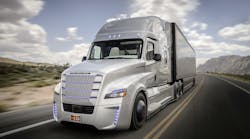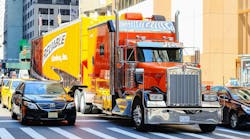Heavy truck accidents account for 3,800 fatal crashes a year, 3,900 deaths annually, 100,000 injuries, and 13% of all traffic fatalities. That’s according to Daniel Blower, an associate research scientist at the University of Michigan’s transportation Research Institute.
According to Blower, those numbers really aren’t that high, and there’s technology out there that can drive them down even more.
Blower was one of three expert panelists who spoke during a recent Truckload Carriers webinar, “Truck Safety in the New Age of Technology.” The panel discussed safety systems – such as active brake assist (ABS), electronic stability control and forward collision warning – and how technology affects the driving experience. Panelists also took on platooning, vehicle-to-vehicle communication and autonomous vehicles.
Alan Korn, director of advanced brake system integration at Meritor, reviewed some of the near-term truck safety technologies and where they might evolve in the next five to 10 years. But first, he referenced a recent New York Times op-ed, “The trucks are killing us.”
“I found that negative article in the New York Times to be questionable, and I didn’t support it at all,” he said, noting that there has been a “tremendous” drop – 45% – in fatalities in the last 10 years.
Today, he explained, safety systems are designed to assist the driver in maintaining control of the vehicle and reducing crash risk. Three current systems – ABS, stability control and collision mitigation – were designed to work seamlessly with each other, Korn explained.
“These systems are designed to assist the driver, not replace the driver,” Korn explained, adding that the key is to curb negative driving patterns before something negative occurs. “These systems can help but it’s the driver’s responsibility to make sure the vehicle is driven safely. We can’t always eliminate crashes, but we can mitigate crashes.”
Looking ahead, within the next 10 years or so, Korn said we will see systems that allow for limited driving capability and trucks that can operate for periods of time with no driver control.
These trucks will include 360-degree awareness so the control system can see everything around the vehicle, he explained. In addition, drivers will see full control of the tractor-trailer, and the system will be set up to alert drivers of changes and tells drivers when to get back engaged with the vehicle and the driving process.
He also addressed his projections for platooning technology and vehicle-to-vehicle communications (V2V).
Technologies put to work
Derek Rotz, senior manager of advanced engineering for Daimler Trucks North America (DTNA), discussed how future technologies would be put into place and what it would mean for fleet managers and drivers.
He mentioned that earlier this year DTNA launched its autonomous Inspiration Truck, which takes over steering, braking and throttling duties from the driver and will temporarily relieve the driver of the more mundane tasks of driving.
Rotz explained that the systems will constantly evaluate a situation and look at lane markings and vehicles in front of the truck. The vehicle will only go into self-driving mode after certain criteria is met, he said. The driver then clicks the cruise control activation switch and the vehicle is then in control of steering, throttling and braking.
“Hands and feet are off,” he said. “But the brain is always on driving.”
The driver is expected to be in the driver seat and take control if an override countdown occurs. In the event that the driver does not take over control, the vehicle will slow down to a standstill on the road.
Drivers, Rotz explained, will have to put a lot of trust into this new technology. Going forward, fleets must implement specific driving training and trust-building activities with the autonomous vehicles.
“Driver acceptance is a big one,” he said. “Removing the driver from the mundane task definitely has some benefits to it, in my opinion. Safety and driving training would be biggest impacts for fleets.”
One of the benefits he discussed is once a driver is able to take his or her hands off the wheel and eyes off the road temporarily, they can look out the window and enjoy the scenery. This, he added, makes driving a more enjoyable experience and less cognitively straining.
When it comes to platooning, Rotz said there will be a large impact on fuel economy – a 3% fuel savings for the lead truck, and 7% fuel savings for following vehicles. Similar to autonomous trucks, fleets would have to change their driver training and safety policies, and, Rotz explained, it would also impact driver acceptance and fleet operations policies.
According to webinar panelists, by 2030, the prototypical driver will look about the same.
“We will still have to have a very skilled driver controlling the vehicle,” Korn said. “But we will eliminate some of the mundane aspects of driving.”
Panelists also explained that as technologies evolve, regulations and testing standards will also change. Automated vehicles will be subjected to a series of tests to make sure systems will be compliant with those tests.
Pending and upcoming heavy truck regulations include:
-
ESC for truck tractors and buses: A final rule was issued on June 23, 2015; implementation will initiate on standard tractors in August 2017 and certain buses June 2018.
-
Automatic emergency braking (AEB): NHTSA regulatory decision expected 2016.
-
V2V communications: NHTSA regulatory decision in 2015.
-
Greenhouse Gas Phase II: Proposed rule issued on July 13, 2015. Aggressive power unit and trailer requirements.
In his conclusion, Blower mentioned that safety technology has made heavy trucking operations significantly safer over the last decade. However, he added, there are limitations and caveats. A potential downside to some of the technology is that drivers may use it as a safety net and think they can reduce their vigilance of the road.
“These technologies are designed not to replace driver vigilance, but to supplement it,” he said. “Overall, I would say the evidence we have so far would have a significant impact on heavy truck safety.”




